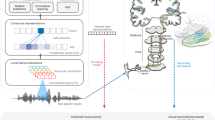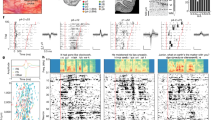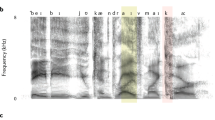Abstract
Speech recognition in the human brain depends on spectral analysis coupled with temporal integration of auditory information. In primates, these processes are mirrored as selective responsiveness of neurons to species-specific vocalizations. Here, we used computational modeling of cortical neural networks to investigate how they achieve selectivity to speech stimuli. Stimulus material comprised multiple pseudowords. We found that synaptic depression was crucial for the emergence of neurons sensitive to the temporal structure of the stimuli. Further, the subdivision of the network into several parallel processing streams was needed for stimulus selectivity to occur. In general, stimulus selectivity and temporal integration seems to be supported by networks with high values of small-world connectivity. The current results might serve as a preliminary pointer for developing speech recognition solutions based on the neuroanatomy and -physiology of auditory cortex.
Access this chapter
Tax calculation will be finalised at checkout
Purchases are for personal use only
Preview
Unable to display preview. Download preview PDF.
Similar content being viewed by others
References
Scharenborg, O.: Reaching Over the Gap: A Review of Efforts to Link Human and Automatic Speech Recognition Research. Speech Comm. 49, 336–347 (2007)
Young, E.D.: Neural Representation of Spectral and Temporal Information in Speech. Phil. Trans. R. Soc. B 363, 923–945 (2008)
Nelken, I.: Processing of Complex Stimuli and Natural Scenes in the Auditory Cortex. Current Opin. Neurobiol. 14, 474–480 (2004)
Binder, J.R., Frost, J.A., Hammeke, T.A., Bellgowan, P.S., Springer, J.A., Kaufman, J.N., Possing, E.T.: Human Temporal Lobe Activation by Speech and Nonspeech Sounds. Cereb. Cortex 10, 512–528 (2000)
Leaver, A.M., Rauschecker, J.P.: Cortical Representation of Natural Complex Sounds: Effects of Acoustic Features and Auditory Object Category. J. Neurosci. 30, 7604–7612 (2010)
Kaas, J.H., Hackett, T.A.: Subdivisions of Auditory Cortex and Processing Streams in Primates. Proc. Natl Acad. Sci. USA 97, 11793–11799 (2000)
Hackett, T.A., Stepniewska, I., Kaas, J.H.: Subdivisions of Auditory Cortex and Ipsilateral Cortical Connections of the Parabelt Auditory Cortex in Macaque Monkeys. J. Comp. Neurol. 394, 475–495 (1998)
Rauschecker, J.P., Tian, B., Hauser, M.: Processing of Complex Sounds in the Macaque Nonprimary Auditory Cortex. Science 268, 111–114 (1995)
Rauschecker, J.P.: Processing of Complex Sounds in the Auditory Cortex of Cat, Monkey, and Man. Acta Otolaryngol. Suppl. 532, 34–38 (1997)
Tian, B., Reser, D., Durham, A., Kustov, A., Rauschecker, J.P.: Functional Specialization in Rhesus Monkey Auditory Cortex. Science 292, 290–293 (2001)
May, P.J.C., Tiitinen, H.: Mismatch Negativity (MMN), the Deviance-Elicited Auditory Deflection, Explained. Psychophysiol 47, 66–122 (2010)
Wilson, H.R., Cowan, J.D.: Excitatory and Inhibitory Interactions in Localized Populations of Model Neurons. Biophys. J. 12, 1–24 (1972)
Loebel, A., Nelken, I., Tsodyks, M.: Processing of Sounds by Population Spikes in a Model of Primary Auditory Cortex. Front. Neurosci. 1, 197–209 (2007)
Wang, X., Lu, T., Snider, R.K., Liang, L.: Sustained Firing in Auditory Cortex Evoked by Preferred Stimuli. Nature 435, 241–346 (2005)
Stephens, J.D.W., Holt, L.L.: A standard set of American-English voiced stop-consonant stimuli from morphed natural speech (submitted) , http://www.u.arizona.edu/~alotto/ACNS/StimuLibrary.htm
Rubinov, M., Sporns, O.: Complex network measures of brain connectivity: Uses and interpretations. NeuroImage 52, 1959–1969 (2010), http://www.brain-connectivity-toolbox.net
Jaeger, H., Haas, H.: Harnessing Nonlinearity: Predicting Chaotic Systems and Saving Energy in Wireless Communication. Science 304, 78–80 (2004)
Deng, Z., Zhang, Y.: Collective Behavior of a Small-World Recurrent Neural System with Scale-Free Distribution. IEEE Trans. Neural Netw. 18, 1364–1375 (2007)
Author information
Authors and Affiliations
Editor information
Editors and Affiliations
Rights and permissions
Copyright information
© 2011 Springer-Verlag Berlin Heidelberg
About this paper
Cite this paper
May, P.J.C., Tiitinen, H. (2011). Speech Recognition Based on the Processing Solutions of Auditory Cortex. In: Honkela, T., Duch, W., Girolami, M., Kaski, S. (eds) Artificial Neural Networks and Machine Learning – ICANN 2011. ICANN 2011. Lecture Notes in Computer Science, vol 6792. Springer, Berlin, Heidelberg. https://doi.org/10.1007/978-3-642-21738-8_54
Download citation
DOI: https://doi.org/10.1007/978-3-642-21738-8_54
Publisher Name: Springer, Berlin, Heidelberg
Print ISBN: 978-3-642-21737-1
Online ISBN: 978-3-642-21738-8
eBook Packages: Computer ScienceComputer Science (R0)




